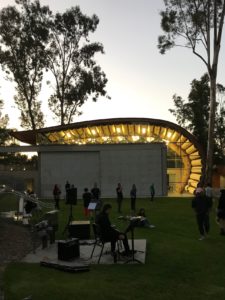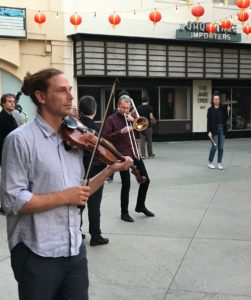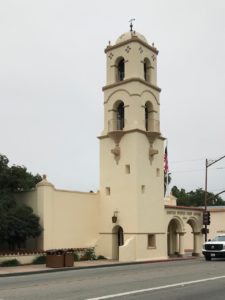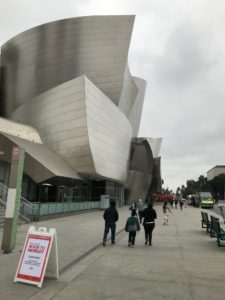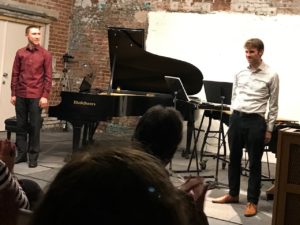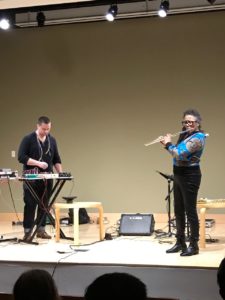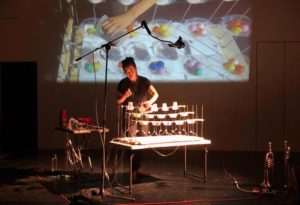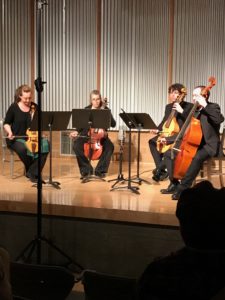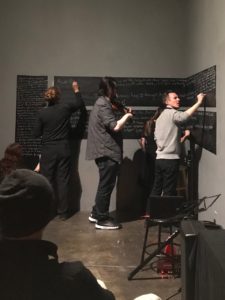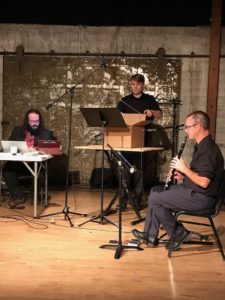 On Saturday, August 10, 2019 wasteLAnd presented its first Summer Academy for Composition Concert at Art Share in downtown Los Angeles. The work of eight emerging composers was performed at this event with each having participated in an intensive course of study in contemporary music during the previous week. Their pieces were work-shopped with the musicians of the wasteLAnd ensemble and reviewed by the Academy faculty of Michelle Lou, Michael Pisaro, and Brian Griffeath-Loeb. A fine crowd filled the Art Share performance hall on a warm Los Angeles summer evening in the lively downtown Los Angeles Arts District.
On Saturday, August 10, 2019 wasteLAnd presented its first Summer Academy for Composition Concert at Art Share in downtown Los Angeles. The work of eight emerging composers was performed at this event with each having participated in an intensive course of study in contemporary music during the previous week. Their pieces were work-shopped with the musicians of the wasteLAnd ensemble and reviewed by the Academy faculty of Michelle Lou, Michael Pisaro, and Brian Griffeath-Loeb. A fine crowd filled the Art Share performance hall on a warm Los Angeles summer evening in the lively downtown Los Angeles Arts District.
The first participant premiere was To the dust of the well or They wore the sky on their chests a breath, a glance, a sign, (confiding a shadow), by Adam Zuckerman. A string trio consisting of a violin, viola and cello was on the stage, with electronic accompaniment played through the large speakers mounted above. The strings began the piece with soft, sustained tones, but this was overtaken by a low rumbling in the speakers that gradually increased in volume until the strings were only barely audible. After a few moments, the speakers went quiet, issuing just a few sporadic clanks and rattles, and this pause uncovered the soft sounds still coming from the trio. The reappearance of the musical tones and the intriguing harmonies of the strings quickly captured the attention of the listener, despite the hushed dynamic. After a short respite, the speakers again became active, pouring out what seemed to be a stream continuous white noise that once more covered up the strings. The cycle repeated, so that each time the noise ceased and the sounds of the trio re-emerged, one’s listening and focus automatically increased. The brain became conditioned to suspend aural attention when there was noise, as if waiting for the weather to clear, so that the musical tones could be given full concentration when they reappeared. To the dust of the well… is an interesting experiment in the engagement of listener perception by the alternation of loud noise and subtle musical sounds.
Luster was next, by Daniel Allas, and this featured a much larger ensemble that included bass clarinet, prepared guitar, percussion, euphonium and piccolo. Luster opened with a random series of solitary clicks that gradually increased in frequency. This was soon joined by a sustained ratcheting sound, filling the space with a wonderfully rhythmic atmosphere. Sharp piccolo riffs spiked through the air, adding to the free-form feel. A loud, sudden and sustained chord from the winds completely recast the texture, however. The prepared guitar, set flat on a table and bowed with a dowel, soon dominated with a series of rough, scratching sounds that immediately produced a sense of high anxiety. Just when it seemed unbearable, the guitar sounds ceased and a low fluttering came from the euphonium and bass clarinet. A soprano voice called out in a mournful wail, bringing the sense of distress to a maximum. The various parts began to drop out until only the low flutter of the winds remained before all sounds stopped suddenly. Luster fearlessly explores new trails into the unsettled territory of the powerfully distraught.
Evolvement II.B, by Kimia Koochakzadeh-Yazdi followed and this began with the soft sound of an inverted metal bowl rubbed on a large square wooden surface. Airy sounds issued from the flute and clarinet while a low tremolo was barely heard from the viola. The speakers contributed some brief tones before dispensing a deep growl that gradually increased in volume. The instruments remained very soft although the air sounds from the flute were strongly audible and helped to create a ghostly atmosphere. A rubber ball dragged over a drum head and amplified contributed a loud fluttering sound that dominated the the unsettling texture, and added a powerful sense of menace. The instruments followed with a greater volume and the flute again was effective with the unlikely technique of rattling its keys. A hair-raising blast from the piccolo and the rising of the instruments in a great crescendo was heard, followed by the sudden cessation of all sound. Evolvement II.B is an instructive study in the building of tension through unexpected sounds made on standard instruments.
Webkitz, by Kelley Sheehan was preceded by a short explanation of the QR code that was attached to each concert program. At a certain point during the performance, those in the audience with cell phones were invited to take a photo of the QR code, and this would bring up a website that would allow individual interaction with the piece being. An overhead projection displayed a color-coded grid . A simple tapping rhythm was heard in the speakers, and as this repeated it increased in complexity. After a minute or two, a performer entered the stage and sat at the table holding a computer. By activating parts of the colored grid, as projected on the screen, additional rhythmic patterns were formed. The performer than rose from the computer table, crossed the stage, and began adding to the rhythms with a drum. This process occurred a total three times – a new performer arriving at the computer, adding some new rhythms from the grid, and moving to an acoustic instrument on stage, to add more notes. By now there was a great cloud of sounds – the rhythmic clicking in the speakers as well as drumming and mournful guitar sounds coming from on stage.
